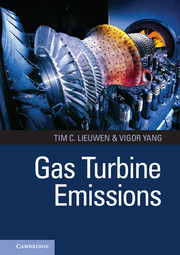Book contents
- Frontmatter
- Contents
- List of Contributors
- Foreword
- Preface
- Part 1 Overview and Key Issues
- Part 2 Fundamentals and Modeling: Production and Control
- 5 Particulate Formation
- 6 Gaseous Aerosol Precursors
- 7 NOx and CO Formation and Control
- 8 Emissions from Oxyfueled or High-Exhaust Gas Recirculation Turbines
- Part 3 Case Studies and Specific Technologies: Pollutant Trends and Key Drivers
- Index
- References
7 - NOx and CO Formation and Control
from Part 2 - Fundamentals and Modeling: Production and Control
Published online by Cambridge University Press: 05 June 2013
- Frontmatter
- Contents
- List of Contributors
- Foreword
- Preface
- Part 1 Overview and Key Issues
- Part 2 Fundamentals and Modeling: Production and Control
- 5 Particulate Formation
- 6 Gaseous Aerosol Precursors
- 7 NOx and CO Formation and Control
- 8 Emissions from Oxyfueled or High-Exhaust Gas Recirculation Turbines
- Part 3 Case Studies and Specific Technologies: Pollutant Trends and Key Drivers
- Index
- References
Summary
Introduction
The majority of the worldwide demand for electricity and transportation is currently met through the combustion of fossil fuels such as natural gas, petroleum-based liquid fuels, coal, and biomass. As a result, combustion remains one of the major anthropogenic sources of pollutant emissions. Key pollutants generated by combustion of hydrocarbon fuels include nitrogen oxides (NyOx), carbon monoxide (CO), sulfur oxides (SOx), unburned hydrocarbons (UHC), and particulate matter (PM). The primary nitrogen oxides generated from combustion systems are nitric oxide (NO), nitrogen dioxide (NO2), and nitrous oxide (N2O). The sum of NO and NO2 is generally referred to as NOx. Nitrogen oxides are a primary air pollutant linked to photochemical smog, acid rain, tropospheric ozone, ozone layer depletion, and global warming (Prather and Sausen, 1999; Skalska et al., 2010). When released in the atmosphere, NOx can react photochemically with organic compounds to generate O atoms, which combine with O2 to form ozone (Brasseur et al., 1998). Ground-level ozone formed in this way is one of the major components, along with particulate matter, of photochemical smog (Grewe et al., 2002). NOx can also eventually form N2O5, which reacts with water to form HNO3 (nitric acid), one of the components of acid rain (Brasseur et al., 1998).
Nitrogen oxides and carbon monoxide are primary pollutant emissions formed during the combustion of hydrocarbon fuels in gas turbine engines. Emissions of UHC and PM can also be an issue in gas turbines that operate in non-premixed combustion mode, such as aircraft engines. In addition, the combustion of sulfur-containing liquid fuels, coal, and biomass can generate sulfur oxides (SOx). SOx are generally not a consideration for natural gas combustion as this fuel has a negligible amount of fuel-bound sulfur. Interested readers are encouraged to review the chapter on gas aerosol precursors for a detailed discussion on SOx emissions. Formation of H2O and CO2 is a major fraction of the gas turbine exhaust during the combustion of hydrocarbon fuels, and these substances play a role in global climate change as they act as greenhouse gases (Prather and Sausen, 1999).
- Type
- Chapter
- Information
- Gas Turbine Emissions , pp. 175 - 208Publisher: Cambridge University PressPrint publication year: 2013
References
- 5
- Cited by



